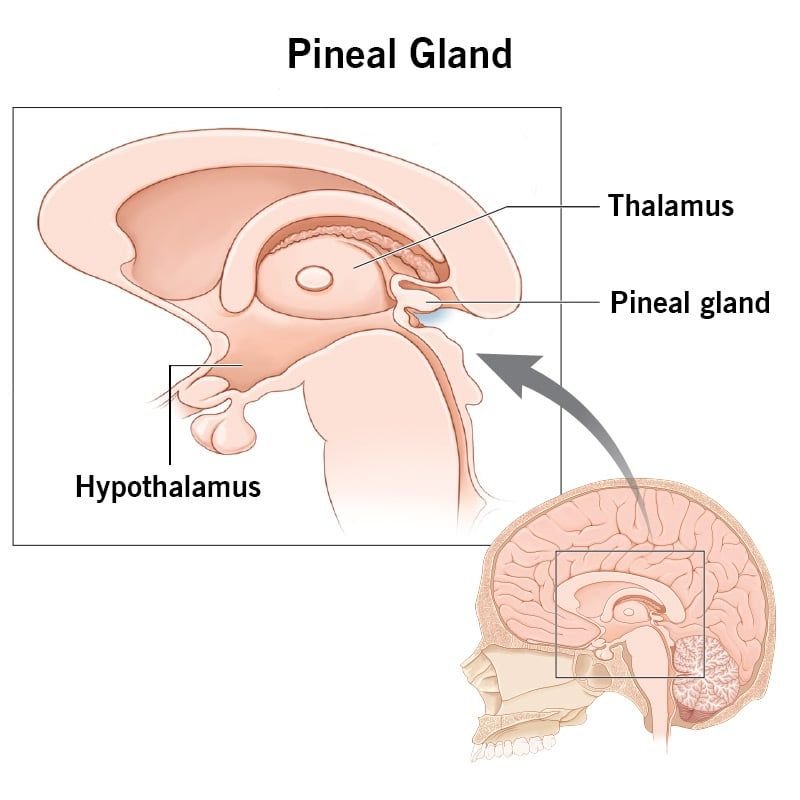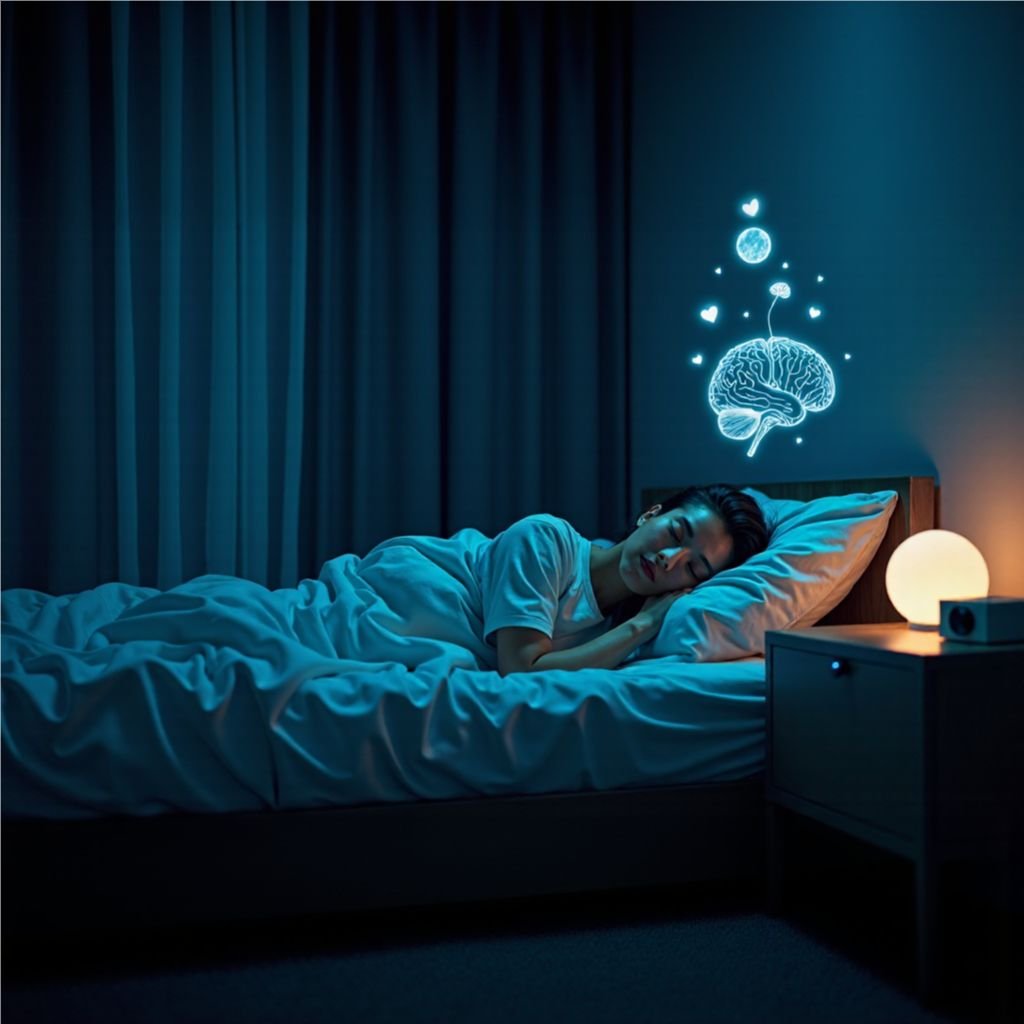Have you ever wondered why you feel sleepy at night and alert during the day? Or why light and darkness affect your mood so strongly? The answer lies in a small organ hidden deep in your brain-the pineal gland.

For centuries, people have asked, “What is the pineal gland and what does it do?” Some call it the “third eye,” others the “seat of the soul,” while scientists know it as an important part of the endocrine system.
In this guide, we will explore everything about the pineal gland: its structure, functions, location, myths, and how to keep it healthy.
What Is the Pineal Gland?
The pineal gland, also called the pineal body or glandula pineal, is a tiny endocrine gland in the brain. It is about the size of a grain of rice, shaped like a pinecone, and located between the two halves of the thalamus.
Even though it is small, the pineal gland function is essential for our daily life. It produces melatonin, the hormone that regulates sleep cycles.
The term “penial gland” is sometimes mistakenly used, but the correct spelling is pineal gland.
Fact: The pineal gland is only 5-8 mm in length but plays a vital role in balancing hormones and biological rhythms.
Where Is the Pineal Gland Located?
The pineal gland location is deep inside the brain, tucked in a groove where the two halves of the thalamus join. Because of its central position, it acts like a bridge between the nervous system and the endocrine system.
When people ask, “Where is the pineal gland located?”, the easiest answer is: in the middle of the brain, behind the third ventricle.
Anatomy and Structure of the Pineal Body
The pineal body is unique because it does not have a strong blood-brain barrier like other parts of the brain. This allows it to receive signals and nutrients more freely.
It contains two main types of cells:
- Pinealocytes: Cells that produce melatonin.
- Glial cells: Supporting cells that help maintain function.
It also has a rich blood supply, making it highly responsive to changes in light and dark cycles.
What Does the Pineal Gland Do?
So, what does the pineal gland do? Its main role is to produce melatonin and regulate the body’s internal clock, known as circadian rhythms. But it does more:
- Regulates Sleep: Produces melatonin to help you fall asleep at night.
- Controls Biological Cycles: Influences puberty, seasonal rhythms, and hormonal balance.
- Connects Brain and Hormones: Acts as a link between the nervous system and the endocrine system.
When you think of the pineal gland, imagine it as your body’s natural timekeeper.
Pineal Gland Function in Sleep and Hormonal Balance

The pineal gland function is most visible in how it regulates the sleep-wake cycle. During the day, melatonin levels stay low. At night, they rise, making you sleepy. This cycle, known as the circadian rhythm, is essential for good health.
Besides sleep, the gland also influences puberty, mood, and stress by interacting with other hormones like cortisol and serotonin.
Fact: Research shows that people exposed to bright screens at night produce less melatonin, leading to sleep disorders.
Melatonin: The Key Hormone of the Pineal Gland
When people ask, “What is the pineal gland and what does it do?” the best answer is: it produces melatonin.
Melatonin is more than just a sleep hormone:
- It improves sleep quality.
- It strengthens the immune system.
- It acts as an antioxidant, protecting cells from damage.
- It regulates mood and reduces stress.
As we age, melatonin production decreases, which explains why older adults often struggle with sleep and immunity.
Pineal Gland Calcification
One of the most common issues with the pineal gland is calcification. Over time, calcium deposits build up inside the gland, making it less effective.
- Common after the age of 40.
- Linked to sleep problems, migraines, and mood disorders.
- Possibly influenced by fluoride and environmental toxins.
Fact: Studies show that in some elderly people, the pineal gland is almost fully calcified, reducing melatonin output dramatically.
What Happens When the Pineal Gland Is Activated?
Many spiritual traditions talk about “activating” the pineal gland. But what happens when the pineal gland is activated?
From a scientific view, activation simply means proper functioning-healthy melatonin release, strong circadian rhythm, and hormonal balance.
From a spiritual perspective, activation is linked to higher consciousness, intuition, and enlightenment. Meditation, yoga, and mindfulness are believed to stimulate this “third eye,” though scientific evidence is limited.
Pineal Gland and Spiritual Beliefs
Throughout history, the pineal gland has been surrounded by mystery:
- Ancient Egypt: Linked with the Eye of Horus.
- Hinduism and Buddhism: Connected with the “third eye chakra,” a symbol of wisdom and intuition.
- Western Philosophy: René Descartes called it the “seat of the soul.”
While modern science views the pineal gland mainly as a hormone regulator, these beliefs continue to inspire people to explore its deeper meaning.
Pineal Gland Disorders and Health Issues
Like any organ, the pineal gland can face problems:
- Calcification – Reduces melatonin production.
- Cysts – Usually harmless, but sometimes cause headaches or vision issues.
- Tumors – Rare but may lead to nausea, hormonal imbalance, or eye movement problems.
- Sleep Disorders – Insomnia, delayed sleep phase, and seasonal affective disorder.
Fact: The National Institutes of Health estimates that 50–70 million Americans suffer from sleep disorders, many of which may be linked to pineal gland dysfunction.
How to Keep the Pineal Gland Healthy
If you are concerned about the pineal gland and want to maintain its health, here are proven steps:
- Sunlight Exposure: Reset your biological clock with natural light.
- Reduce Blue Light: Avoid screens before bedtime.
- Eat Healthy Foods: Magnesium-rich foods, nuts, and green vegetables.
- Improve Sleep Hygiene: Go to bed at the same time daily.
- Limit Toxins: Reduce fluoride and chemicals where possible.
- Exercise and Meditation: Both improve sleep quality and reduce stress.
Pineal Gland in Research and Medicine
Scientists are still studying the pineal gland’s role in health:
- Neurodegenerative Diseases: Melatonin protects against Alzheimer’s and Parkinson’s.
- Cancer Treatment: Melatonin may slow tumor growth.
- Immune Function: Helps regulate immune responses.
- Mental Health: Supports mood stability and reduces the risk of depression.
How to Support Pineal Gland Health Naturally
If you want to keep your pineal gland strong, here are proven steps:
- Prioritize Natural Light Exposure – Morning sunlight helps reset your circadian rhythm.
- Reduce Blue Light at Night – Avoid screens before bed, or use blue light filters.
- Eat Pineal-Supportive Foods – Dark leafy greens, nuts, seeds, bananas, and foods rich in magnesium support melatonin production.
- Get Enough Sleep – Stick to a consistent bedtime and wake-up time.
- Stay Active – Exercise improves hormonal balance and sleep quality.
- Consider Supplements Carefully – Melatonin supplements can help in short-term cases of insomnia, jet lag, or shift work.
FAQs on the Pineal Gland
Q1. What is the pineal gland?
It is a small endocrine gland in the brain that produces melatonin and regulates sleep.
Q2. Where is the pineal gland located?
In the middle of the brain, between the two halves of the thalamus.
Q3. What does the pineal gland do?
It regulates circadian rhythm, sleep cycles, and hormonal balance.
Q4. What happens when the pineal gland is activated?
Scientifically, better sleep and hormone balance. Spiritually: believed to enhance intuition.
Q5. What is pineal gland calcification?
It is the buildup of calcium deposits that reduces its function over time.
Q6. Is the pineal gland really the “third eye”?
Spiritually, many cultures call it the third eye. Scientifically, it is an endocrine gland with real functions in regulating hormones.
Conclusion
The pineal gland may be small, but its impact is huge. It regulates sleep, mood, hormones, and even aging. While myths and spirituality surround it, science proves its role as the body’s natural timekeeper.
So the next time you wonder, “What is the pineal gland and what does it do?”, remember: it is both a biological wonder and a symbol of human curiosity. Whether you call it the pineal body, glandula pineal, or even mistakenly the pineal gland, its function remains one of the most fascinating in the human body.